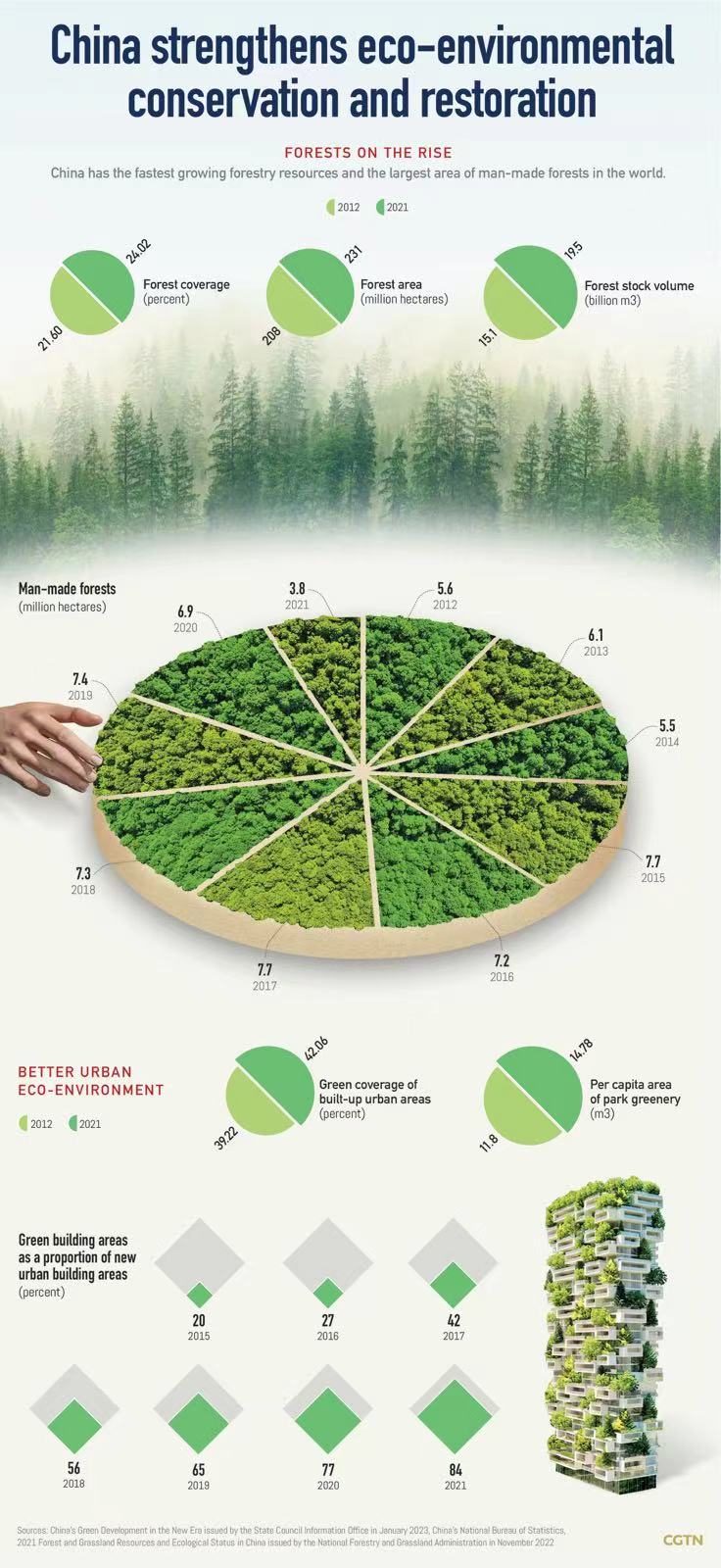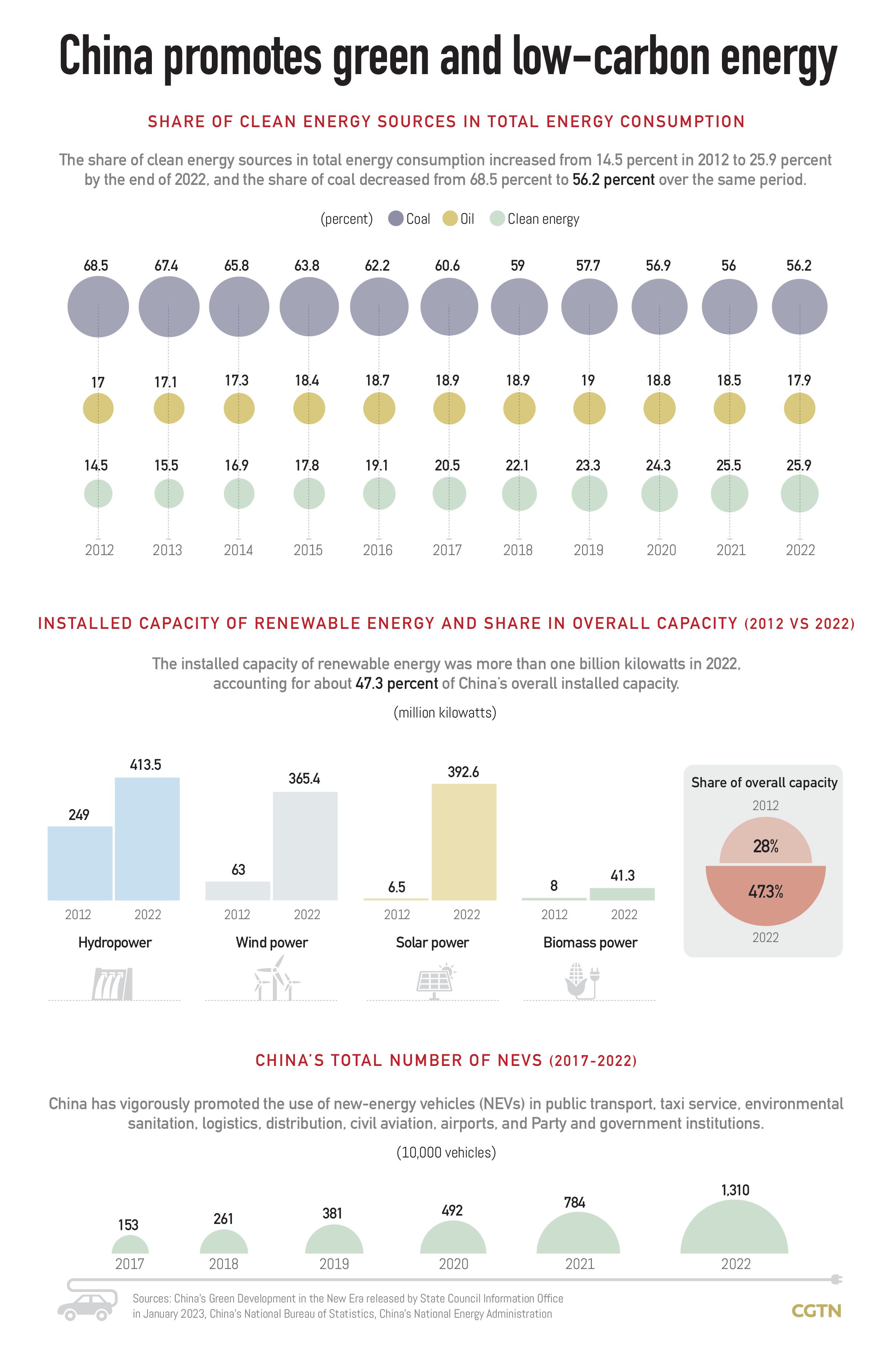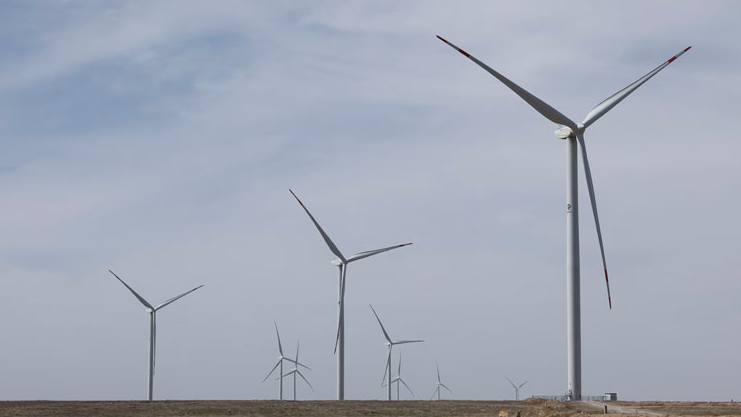
Finless porpoises surf in the section of the Yangtze River in Yichang City, central China's Hubei Province, May 17, 2023. /CFP
Finless porpoises surf in the section of the Yangtze River in Yichang City, central China's Hubei Province, May 17, 2023. /CFP
Five years have passed since Chinese President Xi Jinping said China will push ecological civilization to a new level during a tone-setting meeting on environmental protection held in May 2018.
Over the years, China has witnessed several firsts in its ecological protection, such as the Yangtze River Protection Law — the country's first legislation on a specific river basin — and its first batches of national parks including the Giant Panda National Park.
Besides, China, with its per capital resources below the global average, has all long been striving for a human-nature harmony in its modernization drive.

"Humanity and nature make up a community of life. If we extract from nature without limit or inflict damage on it, we are bound to face its retaliation," reads Xi's report to the 20th National Congress of the Communist Party of China. "China is committed to sustainable development and to the principles of prioritizing resource conservation and environmental protection and letting nature restore itself."
In recent years, the country has stepped up the development of a national park-based nature reserve system, drawn up ecological conservation red lines nationwide, and pushed for the integrated conservation and systematic restoration of mountains, rivers, forests, farmlands, lakes, grasslands and deserts.
The first batch of national parks including the Giant Panda National Park were established last year and more are in the pipeline. Nearly 10,000 nature reserves have been established over the years, accounting for about 18 percent of the total land area, according to the white paper "Biodiversity Conservation in China," published by the State Council Information Office in 2021.
Read more:
Graphics: Biodiversity conservation in China

China has won international support for its innovative initiative to draw up ecological conservation red lines nationwide, covering zones critical to environmental function or ecologically sensitive to protect the vast majority of rare and endangered species and their habitats.
The efforts have paid off. The population of giant pandas in the wild has grown from 1,114 to 1,864 over the past 40 years and the number of Hainan gibbons, the world's rarest primate and the most endangered among all gibbon species on the planet, has increased from less than 10 in the 1980s to at least 36 today.
Still, thanks to the reforestation efforts in the past few years, China's forest resources have increased by more than 70 million hectares in the past decade, ranking first in the world.
Read more:
Graphics: China strengthens eco-environmental conservation and restoration
In addition to prioritizing resource conservation and environmental protection, the world's biggest developing country has in recent years enhanced its green transition on the way of pursuing high-quality development to achieve its "dual carbon" goal — a peak carbon dioxide emission before 2030 and carbon neutrality before 2060.
From 2012 to 2022, China had seen a continuous growth of clean energy consumption and a remarkable growth of the installed capacity of renewable energy including wind power and solar power.

Data from the National Bureau of Statistics showed the share of clean energy sources in total energy consumption increased from 14.5 percent in 2012 to 25.9 percent by the end of 2022, and the share of coal decreased from 68.5 percent to 56.2 percent over the same period.
During the same period, the installed capacity of solar power grew from 6.5 gigawatts to 392.6 gigawatts — a 60-fold increase.
As for the emerging new energy vehicles (NEV), China not only boasts the world's largest number of registered NEVs — which totaled 1.31 million in 2022, but also ranks first worldwide on the production and sales volume of NEVs for eight consecutive years.
"China's renewable energy development has made positive contribution to global emission reduction. In 2022, a total of 2.83 billion tonnes of emissions were cut, accounting for about 41 percent of the global emissions reduced by renewable energy during the same period," said Wang Dapeng, deputy head of the new energy and renewable energy department at the National Energy Administration, at a press conference in February.
Read more:
Graphics: China forges ahead on the green path

Wind turbines are seen at central Asia's largest wind farm built by a Chinese firm near the city of Zhanatas in the Zhambyl Region, Kazakhstan, May 24, 2021. /Xinhua
Wind turbines are seen at central Asia's largest wind farm built by a Chinese firm near the city of Zhanatas in the Zhambyl Region, Kazakhstan, May 24, 2021. /Xinhua
Acknowledging China has reached world's leading level in filed including photovoltaic and NEVs, Ivona Ladjevac, deputy director of the Institute of International Politics and Economics in Belgrade, spoke highly of the supports China has offered to the actions taken by other developing countries to achieve their own green and low carbon government.
Noting China has cooperated with many countries in building clean energy projects such as wind power and photovoltaic power station, Ladjevac said all those showed China makes positive contribution to global green development.
Besides, China has also been an active participant in global diversity protection. China was among the first to sign and ratify the Convention on Biological Diversity (CBD) and has become the largest contributor to the core budget of the CBD and its protocols since 2019.
According to China's white paper on biodiversity conservation, the country has supported more than 80 developing countries in biodiversity conservation under the framework of South-South cooperation.
Xi said China will do its best to support and assist fellow developing countries through the Belt and Road Initiative International Green Development Coalition to elevate global biodiversity governance to a new height while delivering a speech at the opening ceremony of the high-level segment of the second part of the 15th meeting of the Conference of the Parties to the Convention on Biological Diversity, or COP15, via video last December.
Read more:
CGTN Poll: Global population hails China's work on eco-civilization